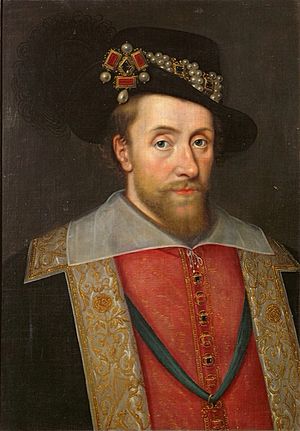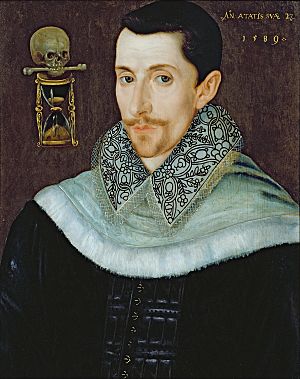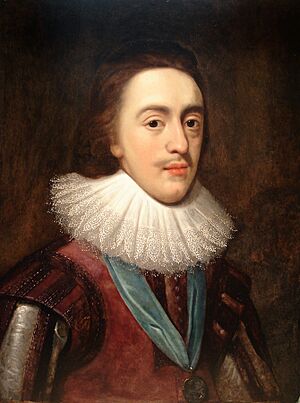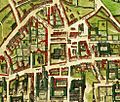Orlando Gibbons facts for kids
Orlando Gibbons (born around 25 December 1583 – died 5 June 1625) was a famous English composer and keyboard player. He was one of the last great masters of the English Virginalist School (keyboard music) and English Madrigal School (vocal music).
Gibbons was the most well-known member of a musical family. By the 1610s, he was a leading composer and organist in England. Sadly, his career was cut short when he died suddenly in 1625. Because of this, he didn't write as much music as some other composers of his time, like William Byrd. However, he made big contributions to many types of music. People often see him as a link between the Renaissance and Baroque periods in music history.
Gibbons grew up in a musical family. His father was a town musician (called a wait), and his brothers were also musicians. It's not clear who taught him music, but he likely learned to play the keyboard when he was young. He was talented enough to join the Chapel Royal (a group of musicians for the King) in 1603. By 1605, he became a full-time organist there. In 1606, he earned a music degree from King's College, Cambridge.
Throughout his career, Gibbons became friends with important people in the English court. King James I and Prince Charles supported his work. Along with Byrd and John Bull, Gibbons helped create Parthenia, the first printed collection of English keyboard music. He also published other works, like his First Set of Madrigals and Motets (1612). This collection includes the famous English madrigal, The Silver Swan. Other important pieces include "This Is the Record of John" and "O Clap Your Hands Together." In 1623, Gibbons became the organist at Westminster Abbey, a very important job he held until his death.
Gibbons built on the musical ideas of William Byrd, especially in madrigals and anthems (church songs). His work greatly influenced later English composers. His oldest son, Christopher, also became a musician and taught important composers like John Blow and Henry Purcell. After he died, people mostly remembered Gibbons for his sacred music (church music). But more recently, his other works, like his keyboard pieces and viol fantasies, have become very popular. Today, almost all of his music has been published and recorded.
Life and Career
Early Life and Family
Orlando Gibbons was born in Oxford, England. For a long time, people thought he was born in Cambridge, even though a record showed he was baptized in St Martin's Church, Oxford. Modern historians have now confirmed that he was indeed born in Oxford.
His family had been involved in music for generations. His grandfather, Richard Gibbons, was a glover in Oxford. Orlando's father, William Gibbons, was a town musician (a "wait") in Cambridge and later in Oxford.
Orlando was likely the seventh of nine children. He was baptized on Christmas Day in 1583. It was common then for babies to be baptized within a week of birth, so he was probably born just before Christmas. When Orlando was about 4 or 5 years old, his family moved back to Cambridge, and his father continued working as a town musician there.
Orlando grew up in a very musical home. Not only was his father a musician, but his oldest brother, Edward, was a composer and led the Choir of King's College, Cambridge. His brother Ellis was also a promising composer, and his brother Ferdinando became a town musician like their father. Orlando likely learned to play keyboard instruments and perhaps the viol (a string instrument) at a young age.
When he was 12, Orlando joined his brother Edward's choir at King's College on February 14, 1596. He sang regularly until late 1598. He also enrolled at King's College as a sizar, which meant he paid less for tuition but had to do some chores.
We don't know who taught Gibbons how to compose music. It might have been his brother Edward, or even William Byrd, who was a much older and highly respected composer. Gibbons, Byrd, and John Bull later published music together. Since Bull was Byrd's student, Gibbons might have been too. By the time he left the choir in 1599, at age 15 or 16, Gibbons was already composing.
Joining the Royal Court
By May 1603, Gibbons was skilled enough to become a musician for the Chapel Royal. This was a large group of musicians and priests who served the King and his family. Gibbons started as an unpaid substitute, waiting for a full-time position. King James I had just become king that year, and Gibbons likely performed at his coronation on July 25.
The year 1603 brought both good and bad news for Gibbons. He got his first professional music job, but his mother and brother Ellis both died that same year. Ellis might have died from the plague. In January 1605, a full-time position opened up, and Gibbons became a Gentleman of the Chapel Royal and a junior organist on March 21, 1605. His brother Edward and the senior organist, John Bull, might have helped him get this important job. Gibbons kept this position for the rest of his life.
In 1606, Gibbons married Elizabeth Patten. Her father, John Patten, also worked for the Chapel Royal, so he likely knew Gibbons well. When John Patten died in 1623, he left money to Gibbons's children. Also in 1606, Orlando earned his Bachelor of Music degree from Cambridge. Gibbons and Elizabeth lived in Westminster, where their seven children—James, Alice, Christopher, Ann, Mary, Elizabeth, and Orlando—were baptized.
Published Works and Support
By the 1610s, Gibbons was a well-known composer and the best organist in England. He became good friends with Sir Christopher Hatton, who was a distant cousin of Queen Elizabeth I's favorite. Hatton became an important supporter of Gibbons's music.
In 1612, Gibbons published his First Set of Madrigals and Motets, thanks to Hatton's support. One of the most famous songs in this collection is The Silver Swan. Gibbons dedicated the whole collection to Hatton, saying that many of the songs were written in Hatton's home. This suggests that Hatton might have even written some of the poems that Gibbons set to music.
In 1613, six of Gibbons's pieces were published in Parthenia. This was the first printed collection of English keyboard music, and it also included works by older composers like Byrd and Bull. Parthenia was published to celebrate the wedding of Princess Elizabeth Stuart to Frederick V of the Palatinate. Around this time, Gibbons also wrote anthems for important nobles and clergy, showing his connections within the court.
In 1614, Gibbons had two more songs published in a collection called The Teares and Lamentatacions of a Sorrowfull Soule. By 1615, he was a joint organist of the Royal Chapel. King James I also gave him two grants of money, recognizing his "good and faithful service." Gibbons continued to write for the King, including an anthem called Great King of Gods for the King's visit to Scotland in 1617.
Later Career and Death
By the late 1610s, Gibbons was likely the most important musician and composer at the English court. William Byrd had retired, and John Bull had left England. In 1617, Gibbons became a keyboard player in an ensemble (a music group) for Prince Charles (who later became King Charles I). Gibbons was the only keyboard player in this group of 17 musicians. Prince Charles himself sometimes played the viol with them. Gibbons probably wrote music for this group to perform. Around 1620, Gibbons published his Fantasies of Three Parts.
There's some debate about whether Gibbons received a Doctorate of Music in May 1622. Some records suggest he did, but others don't mention it. The most convincing evidence against it is that his memorial monument, built after his death, doesn't mention him having a doctorate.
Around 1623, Gibbons wrote tunes for most of the songs in a book called Hymnes and Songs of the Church. In the same year, he became the organist at Westminster Abbey, which was a very important job. On May 7, 1625, he played at the funeral of King James I.
In late May 1625, the English court was getting ready to welcome Queen Henrietta Maria, whom King Charles I had married in France. Gibbons and other Chapel Royal members were traveling to Canterbury on May 31 when Gibbons suddenly became ill. He likely had a brain haemorrhage. He died at age 41 in Canterbury and was buried in Canterbury Cathedral. His death shocked everyone. His wife, Elizabeth, died a little over a year later, leaving their children to be cared for by Orlando's oldest brother, Edward.
Character and Skills
Not much is known about Gibbons's personality. Unlike some other composers of his time, his life seems to have been fairly calm. For example, William Byrd often had legal problems, and John Bull had to leave the country.
One unusual event happened in Gibbons's life in 1620. A complaint said that a man named Henry Eveseed attacked Gibbons, throwing him down. Other than this, Gibbons seems to have had good relationships with his employers and fellow musicians. His patron, Sir Christopher Hatton, became a close friend. Hatton and his wife may have even been the namesakes for two of Gibbons's children.
Gibbons's music might give us some clues about him. His career was mostly focused on the royal court, where he was very successful. Getting a job at the Chapel Royal at such a young age (19, then 21) was impressive. All four of his main jobs showed how talented he was as a keyboard player. People at the time praised his skills. One person said that when Gibbons played the organ at Westminster Abbey, it was played by "the best finger of that age." Another said he had "the best hand in England."
Music
Gibbons wrote many keyboard pieces, about thirty fantasias for viols (string instruments), and several madrigals. His most famous madrigal is "The Silver Swan." He also wrote many popular verse anthems (church songs with solo parts), like "Great Lord of Lords." Perhaps his most famous verse anthem is "This Is the Record of John," which features a solo singer and a full choir. He also created two major settings of Evensong (church services). His full anthems include the emotional O Lord, in thy wrath and "O clap your hands together" for eight voices.
Gibbons's keyboard music includes about 45 pieces. He often wrote complex fantasias and dance pieces. His writing shows a strong understanding of counterpoint (combining different melodies). Many of his fantasias are long pieces with multiple sections, using different musical ideas. In his fantasias and dances, Gibbons often developed simple musical ideas in great detail, like in his Pavane in D minor.
Legacy
In the 1900s, the Canadian pianist Glenn Gould loved Gibbons's music and called him his favorite composer. Gould wrote that Gibbons's hymns and anthems "moved me more deeply than any other sound experience." He even compared Gibbons to famous composers like Beethoven.
Gibbons's death on June 5, 1625, is still remembered at King's College Chapel, Cambridge, where his music is often sung during Evensong. Many of his church anthems are included in the Oxford Book of Tudor Anthems.
The music expert Frederick Ouseley called Gibbons the "English Palestrina" (a very famous Italian composer). Gibbons helped shape the future of English music by improving on William Byrd's ideas for madrigals and anthems. He also taught music to his oldest son, Christopher, who then taught important composers like John Blow, Pelham Humfrey, and especially Henry Purcell, who was a pioneer of the Baroque era in England. A modern music critic, John Rockwell, said that Gibbons's music "can still speak directly to the present."
Images for kids
See also
 In Spanish: Orlando Gibbons para niños
In Spanish: Orlando Gibbons para niños











